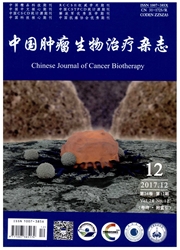

 中文摘要:
中文摘要:
目的:研究荧光磁性纳米粒子与前列腺癌特异性抗原(prostate cancer specific antigen,PSA)单链抗体片段结合的复合纳米探针作为前列腺癌核磁共振靶向显像剂与治疗剂的可行性。方法:荧光磁性纳米粒子(FMCNPs)与前列腺癌特异性单链抗体片段(ScFv)桥联制备成复合纳米探针(FMCNPs-ScFv),应用高分辨电镜、荧光光谱仪与磁强度计进行鉴定。将FMCNPs-ScFv与前列腺癌LNCaP细胞共培养,观察其进入癌细胞的靶向性;采用MTT法评价复合纳米探针的细胞毒性。建立裸鼠前列腺癌细胞移植模型,进行免疫组化和病理学鉴定;荷前列腺癌裸鼠尾静脉注射复合纳米探针,采用荧光成像系统观察纳米探针在裸鼠体内的分布消除过程;利用核磁共振观察复合纳米探针肿瘤靶向显像效果;给予体外磁场照射(100W功率)30min,观察肿瘤体积的变化。结果:成功制备复合纳米探针FMCNPs-ScFv;细胞培养实验显示复合纳米探针能够进入前列腺癌细胞质;在显像浓度范围内复合纳米探针细胞毒性很低,不影响细胞增殖。成功制备裸鼠前列腺癌模型。荧光成像系统显示复合纳米探针快速地在裸鼠各重要器官分布,并逐渐集中于肿瘤部位;核磁共振显示纳米探针在24h内能够清晰显示前列腺癌图像;体外磁场照射4d后,注射复合纳米探针的裸鼠肿瘤组织生长显著慢于对照裸鼠的肿瘤组织(P〈0.05)。结论:制备的复合纳米探针FMCNPs-ScFv能有效地靶向前列腺癌组织,可用于前列腺癌的核磁共振成像,也能用于体外磁场作用下的肿瘤治疗。
 英文摘要:
英文摘要:
Objective:To investigate the feasibility of targeted imaging and therapy of prostate cancer using nanocomposite probes composed of fluorescent magnetic nanoparticles (FMCNPs) and single chain Fv (ScFv) antibody specific for gama-seminoprotein. Methods: The nanocomposite probes (FMCNPs-ScFv) were prepared by conjugating fluorescent magnetic nanoparticles with singlegama-chain Fv antibody specific gama-seminoprotein, and were characterized by high resolution transmission electron microscopy, fluorescent spectrum and magnetic spectrum. Nanocomposite probes were incubated with prostate cancer LNCaP cells, and the targeting results of nanocomposite probes were observed by fluorescent microscopy. The cytotoxicity effect of the nanocomposite probes was measured by MTT. Nude mice models of prostate cancer were established and identified by immunohistochemistry method. The nanocomposite probes were injected into nude mice via tail vein. The distribution of nanocomposite probes in the nude mice was observed by Micro-animal imaging system, targeted imaging of the prostate cancer was observed by MR instrument. The nude mice with prostate cancer were irradiated with 100 W magnetic field for 30 min, and the changes of tumor sizes were observed. Results: The FMCNPs- ScFv nanocomposite probes were successfully prepared. Nanocomposite probes entered into the cytoplasm of cancer cells and exhibited low cytotoxicity effect. Nude mice model with prostate cancer were successfully fabricated; the nanocomposite probes distributed quickly in the main organs of mice, and gradually concentrated on the tumor tissues within 24 h. MR images showed that the tumor images were gradually enhanced from 6 h to 24 h after injection of the nanocomposite probe. Four days after magnetic irradiation, the tumors in the nude mice grew slower compared with the control nude mice ( P 〈 0. 05 ). Conclusion : The nanocomposite probes composed of FMCNPs and ScFv antibody can be used for targeted imaging of prostate cancer by MRI instr
 同期刊论文项目
同期刊论文项目
 同项目期刊论文
同项目期刊论文
 Anti-HIF -1a antibody-conjugated pluronic triblock copolymers encapsulated with Paclitaxel for tumor
Anti-HIF -1a antibody-conjugated pluronic triblock copolymers encapsulated with Paclitaxel for tumor Cloning, Expression, Monoclonal Antibody Preparation of Human Gene NBEAL1 and Its Application in Tar
Cloning, Expression, Monoclonal Antibody Preparation of Human Gene NBEAL1 and Its Application in Tar Fluorescent Magnetic Nanoprobes for in vivo Targeted Imaging and Hyperthermia Therapy of Prostate Ca
Fluorescent Magnetic Nanoprobes for in vivo Targeted Imaging and Hyperthermia Therapy of Prostate Ca Simultaneous targeting of MCL1 and ABCB1 as a novel strategy to overcome drug resistance in human le
Simultaneous targeting of MCL1 and ABCB1 as a novel strategy to overcome drug resistance in human le Degradation of regulator of calcineurin 1 (RCAN1) is mediated by both chaperone-mediated autophagy a
Degradation of regulator of calcineurin 1 (RCAN1) is mediated by both chaperone-mediated autophagy a 期刊信息
期刊信息
